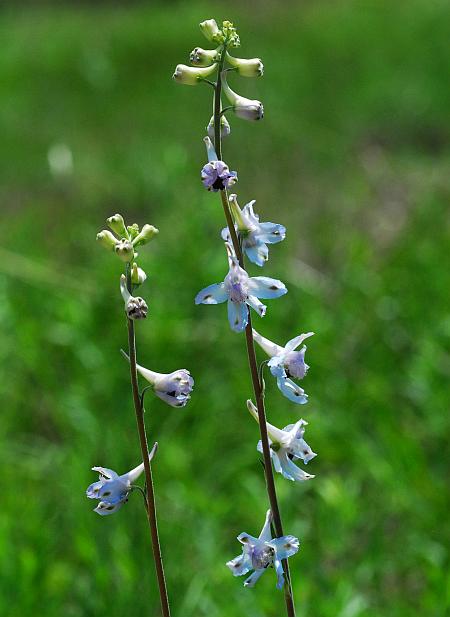Delphinium carolinianum ssp. carolinianum
Carolina Larkspur

Native
CC = 7
CW = 5
MOC = 58
© SRTurner
Delphinium carolinianum ssp. carolinianumCarolina Larkspur | |
 |
Native CC = 7 CW = 5 MOC = 58 |
© SRTurner |
|
Family - Ranunculaceae Habit - Rhizomatous perennial forb, the roots fibrous, sometimes relatively stout, not tuberous. Stems - Erect, single, to 90 cm, moderately to densely short-hairy, less commonly with longer hairs, some of the hairs usually gland-tipped.
Leaves - Alternate, deeply palmately divided, petiolate below to nearly sessile above. Basal rosette often absent at flowering. Stem leaves 5-12 above the rosette. Petioles of the uppermost stem leaves 1-5 mm long. Leaf blades 2.2-7.5 cm long, 4.5-11.0 cm wide, the deepest divisions reaching the blade base, the ultimate segments 1-3 mm wide, linear or narrowly oblanceolate, angled to a bluntly or sharply pointed tip or rounded with an abrupt, minute, sharply pointed tip.
Inflorescence - Narrow terminal racemes, the axis moderately to densely pubescent with minute curled hairs, the flower stalks erect or nearly so, appearing more or less appressed to the inflorescence axis, at least in the lower half of the inflorescence, the lowermost stalks 1.2-3.3 cm long, the bracts subtending the flower stalks all undivided or occasionally the lowermost 3-parted.
Flowers - Sepals pale to deep blue, purple to white, or greenish, the lateral sepals 7-15 mm long, the spur 12-17 mm long, slightly curved upward, rugose. Corollas of 4 free petals, these with the body 4.5-7.5 mm long, white, but often purplish-or bluish-tinged, the lower pair 2-lobed to about the midpoint, bearded on the inner surface. Stamens numerous, surrounding the pistils. Filaments glabrous, greenish-white, compressed, to 6 mm long, some curled, others straight. Anthers olive-greenish brown, 1.8-2.0 mm long. Pistils usually 3.
Fruits - Follicles 10-19 mm long, erect, those developing from a given flower more or less parallel, glabrous or finely short-hairy. Seeds 1.4-2.0 mm long, the outer surface appearing scaly, yellowish brown to brown.
Flowering - May - June. Habitat - Upland prairies, glades, tops of bluffs, savannas, forest openings, railroads, roadsides. Origin - Native to the U.S. Lookalikes - D. carolinianum ssp. virescens, D. treleasei, D. exaltatum. Other info. - This attractive species is found in Missouri predominantly in the southwest and east-central portions of the state, with more scattered populations in the north. Missouri lies near the center of the plant's natural range, which extends southward to Louisiana and somewhat eastward from there. It is uncommon in its namesake Carolinas. The plant is easily recognized by its wand-like inflorescences of interesting flowers, which are held near the central inflorescence axis on short stalks. The color of the flowers can vary from light to dark blue. Pure white flowers usually denote the other subspecies, ssp. virescens. Two additional subspecies are commonly recognized in regions to our south and east. Photographs taken off Hwy 106, Shannon County, MO., 5-23-03 and at Taberville Prairie, MO., 6-7-03 (DETenaglia); also at Shaw Nature Reserve, Franklin County, MO, 5-30-2014 and 6-5-2014, and Danville Conservation Area, Montgomery County, MO, 5-23-2018 (SRTurner). |